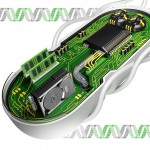What is Synthetic Biology?
Synthetic biology is a new wave of genetic engineering which seeks to bring the field more in line with traditional engineering practices such as standardization and abstraction. Utilizing the technological explosions of the computer and genetic revolutions – synthetic biology is turning science fiction into reality.
Synthetic biology can also refer to the creation of life from scratch. One interpretation of this is the attempt to start with innate chemicals and through specific reactions and driven evolution, create life or life-like organisms. Another approach, taken by Craig Venter and his team, is to place an entirely synthetic genome within a cell which has had its own genome removed – using the old cell to kickstart the new life. Within a short time all of the old cell’s proteins have been replaced by ones coded for in the synthetic genome. Using this approach the first “synthetic organism” Mycoplasma laboratorium (or Synthia) was created.
Synthetic biology is currently largely in a stage of groundwork building. Most work done so far in the field is about developing technologies to make engineering biology easier. In doing this synthetic biology paves the way for greater, more complicated innovation in the future. Another important by-product of this work is an increased understanding of biology itself. The Richard Feynman quote which adorns the top of this site sums this up: “What I cannot create, I do not understand.”
Some Great Introductions
The following video (by James Hutson of Bridge8, hosted by TechNyou) gives a really nice concise explanation of what synthetic biology is, and what makes it different from genetic engineering:
Another great introduction to the field is through the short educational comic “Adventures in Synthetic Biology” [PDF] by Drew Endy, Isadora Deese and Chuck Wadey. This comic was first published in Nature magazine and is a fun introduction to the topic.
What Are The Possibilities?
Finally we may ask, what are the possibilities of this technology? What can we actually do with it? I’d like to give you an excerpt from a well written article from the New York Times by Wil S Hylton to cover this:
The appeal of biological machinery is manifold. For one thing, because organisms reproduce, they can generate not only their target product but also more factories to do the same. Then too, microbes use novel fuel. Chances are, unless you’ve slipped off the grid, virtually every machine you own, from your iPhone to your toaster oven, depends on burning fossil fuels to work. Even if you have slipped off the grid, manufacturing those devices required massive carbon emissions. This is not necessarily the case for biomachinery. A custom organism could produce the same plastic or metal as an industrial plant while feeding on the compounds in pollution or the energy of the sun.
Then there is the matter of yield. Over the last 60 years, agricultural production has boomed in large part through plant modification, chemical additives and irrigation. But as the world population continues to soar, adding nearly a billion people over the past decade, major aquifers are giving out, and agriculture may not be able to keep pace with the world’s needs. If a strain of algae could secrete high yields of protein, using less land and water than traditional crops, it may represent the best hope to feed a booming planet.
Finally, the rise of biomachinery could usher in an era of spot production. “Biology is the ultimate distributed manufacturing platform,” Drew Endy, an assistant professor at Stanford University, told me recently. Endy is trained as an engineer but has become a leading proponent of synthetic biology. He sketched a picture of what “distributed manufacturing” by microbes might look like: say a perfume company could design a bacterium to produce an appealing aroma; “rather than running this in a large-scale fermenter, they would upload the DNA sequences onto the future equivalent of iTunes,” he said. “People all over the world could then pay a fee to download the information.” Then, Endy explained, customers could simply synthesize the bugs at home and grow them on their skin. “They could transform epidermal ecosystems to have living production of scents and fragrances,” he said. “Living perfume!”
All of this has been made possible by the genetic revolution. Read on to find out more.
| Previously – Genetic Engineering | Next Up – The Genetic Revolution |
















